IUCN/SSC Otter Specialist Group Bulletin

©IUCN/SCC Otter Specialist Group
Volume 34 Issue 1 (January 2017)
Citation: Krupa, H, Borker, A and Gopal, A (2017). Photographic Record of Sympatry between Asian Small-Clawed Otter and Smooth-Coated Otter in the Northern Western Ghats, India. IUCN Otter Spec. Group Bull. 34 (1): 51 - 57
Photographic Record of Sympatry between Asian Small-Clawed Otter and Smooth-Coated Otter in the Northern Western Ghats, India
Hannah Krupa1*, Atul Borker2 and Abhishek Gopal3
1 Wild Otters, Kamat Nagar, Porvorim-socorro, Goa,
India 403501 Email hannah@wildotters.com
2Wild Otters, Kamat Nagar, Porvorim-socorro, Goa, India 403501 Email atul@wildotters.com
2Wild Otters, Kamat Nagar, Porvorim-socorro, Goa, India 403501 Email abhishekgopal1993@gmail.com



|
| (Received 25th January 2016, accepted 5th May 2017) |
| Download PDF (789 KB) |
| Abstract: Sympatry was recorded between a family of Asian Small-clawed otters and a family of Smooth-coated otters was observed in Goa, a region in the northern Western Ghats of India. A camera trap was used to monitor otter behaviour for a period of 74 days, during which Asian Small-clawed otters were recorded 17 times and Smooth-coated otters were recorded once. |
| Keywords: Photographic evidence, Trail Camera, Goa, habitat use |
| Française | Español |
Two species are said to be sympatric if they occupy same or overlapping geographic areas. In this case, we describe sympatry between two closely related otter species. Sympatry between a family of Smooth-coated Otters (Lutrogale perspicillata) and a family of Asian Small-clawed Otters (Aonyx cinereus) was recorded using a trail camera in Sonal, Goa, falling in the foothills of northern region of the Western Ghats in India. This is the first time that sympatry between the two otters has been documented with photographic evidence in India.
L. perspicillata and A. cinereus have overlapping ranges in certain parts of India according to the IUCN Red List species distribution map (www.iucnredlist.org). Overlapping ranges indicate possibilities of sympatry. Previous studies have also indicated sympatry, mainly through indirect signs such as spraint comparison. This paper is to confirm their sympatry in the northern Western Ghats through photographic evidence.
Although found in linear riverine habitats, both otter species have different micro and macro habitat preferences. In the Eravikulam region of Western Ghats in Kerala, A. cinereus were found to use pools more extensively than cascades and riffles in the stream types, and 2nd-order streams were preferred over 1st and 3rd-or higher-order streams (Perinchery et al., 2011). Stream substrate, grass cover, and ground cover along banks did not play an important role in influencing A. cinereus presence (Perinchery et al., 2011). L. perspicillata in Periyar Lake in Kerala, Western Ghats were confined to the shallower and narrower regions of the lake, where the bank was gradually sloping mud, and were usually found at the mouths of small streams that join the lake (Anoop and Hussain, 2004).
L. perspicillata is the larger of the two otter species, weighing between 7-11 kg. It is characterized by a very smooth, sleek pelage (Francis, 2001; Hwang and Lariviere, 2005). Colour varies from dark to reddish brown, with the undersides slightly lighter. Upper lip, cheeks, sides of neck, and throat are whitish or gray (Tate, 1947; Hwang and Lariviere, 2005). Underfur and guard hairs are 8 mm and 12 mm in length, respectively. Tail is flattened dorsoventrally, with a distinct lateral keel distally. The rhinarium is black, naked, and situated anteriorly; its dorsal border is barely convex. Vibrissae are well developed, white, and < 90 mm in length. Eyes and ears are small. Limbs are short, strong, with broad feet. All feet are fully webbed (Harrison, 1968; Hwang and Lariviere, 2005). A. cinereus is the smallest otter in the world, weighing less than 3.5 kg. Its head is small, neck is larger than head, legs are short, and tail is flattened dorsoventrally. Pelage is typically brown but sometimes cream coloured or with a reddish tinge (Foster-Turley, 1992; Hwang and Lariviere, 2005).Undersides are paler brown, and edge of upper lips, chin, throat, and sides of neck and face are grayish white. In South India, pelage is darker than elsewhere (Corbet and Hill, 1992; Tate, 1947; Hwang and Lariviere, 2005). Rhinarium is bare. Posterior border of rhinarium is variable in shape from straight to undulated (Yoshiyuki, 1971; Hwang and Lariviere, 2005).
The two otter species differ in terms of their diet as well. A. cinereus feeds mainly on crabs, crustaceans, and other mollusks (Foster-Turley, 1992; Sivasothi and Nor, 1994). It supplements its diet with rodents, snakes and amphibians as well, but these form a small component of its diet (Hussain et al., 2011). L. perspicillata is largely piscivorous, it also known to feed on rats, insects, snakes and a variety of other prey occasionally (Foster-Turley, 1992).
Although there are differences between L. perspicillata and A. cinereus in their macro-habitat, micro-habitat and food preferences (Kruuk, 1994), their apparent range overlap suggests possibilities of overlapping territories and possible interactions as well. Here we give an instance where both the otter species were recorded by the same camera at the same location, albeit on different days.
The study location (Figure 1) is on the bank of a small stream within an areca nut plantation, in the buffer area of Mhadei Wildlife Sanctuary. This stream leads to Mahadayi river. Previous surveys of the area revealed the presence of a latrine site that was used actively as indicated by the presence of fresh spraint (Figure 2). The spraints were provisionally identified to be that of A. cinereus due to the presence of crustacean remains, which are usually finely macerated. A. cinereus is known to feed extensively on crustaceans (Foster-Turley, 1992; Sivasothi and Nor, 1994).
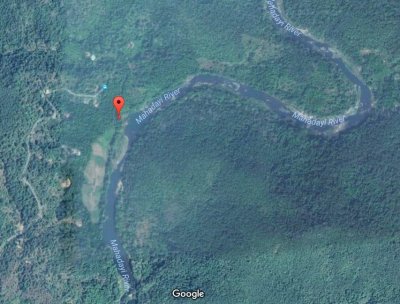 |
| Figure 1. Google image of study location. (click for larger version) |
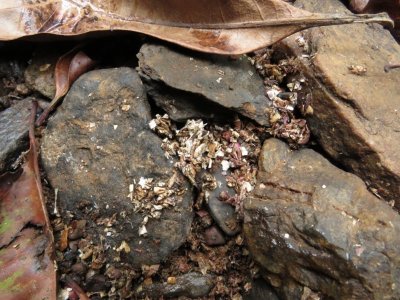 |
| Figure 2. A. cinereus spraint found at study location, characterized by crustacean remains. (click for larger version) |
In order to get more insight of the behaviour of these elusive otters, a trail camera was placed near the latrine site (Figure 3).
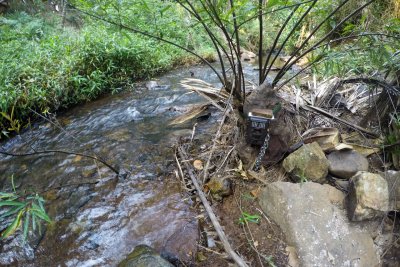 |
| Figure 3. Trail camera placed at the study location. (click for larger version) |
Presence of A. cinereus was recently described in this region (Punjabi et al., 2014). We used a Bushnell HD Trail Camera to capture photographs. The camera was set from 23rd December 2014 to March 8th 2015. The total duration of study was 74 days. The camera was set to monitor all 24 hours a day. It was also set such that it would record a photograph as well as a video upon being triggered. A. cinereus was recorded seventeen times during the study duration, with a maximum family size of three individuals. L. perspicillata was recorded once, with a family size of three individuals (Table 1).
74 days after the camera was set, it was removed and the recorded videos and photos showed that not one, but in fact two species of otters visited the study site (Figure 4 and Figure 5).
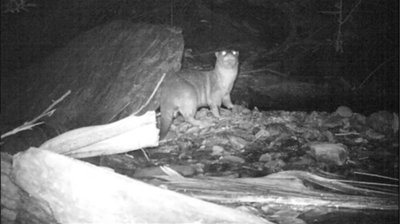 |
| Figure 4. Camera picture of a male Lutrogale perspicillata at the study area. (click for larger version) |
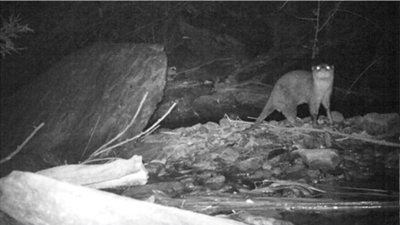 |
| Figure 5. Camera picture of Aonyx cinereus at the study area. (click for larger version) |
The camera records clearly show that the latrine site is visited often by A. cinereus, mainly to defecate and smear its spraint. Three L. perspicillata individuals were recorded at same the location as well. L. perspicillata did not seem to react to the scent or spraint left behind by A. cinereus. The camera record merely shows that the same habitat could be used by both otter species; it gives no further account of their interaction. Although there is evidence that otter species are attracted to the spraint of the other otter species per se, rather than to the same kind of places (Kruuk et al., 1993), this incidental video record shows no specific behaviour to acknowledge this.
When different otter species occur in the same site, there was some evidence for a difference in use of habitat. A. cinereus tracks were often found wandering further away from the river than L. perspicillata, between patches of reeds and river debris (Kruuk, 1994). However, L. perspicillata are not restricted to deep water and often forage in small, shallow rivers (Anoop and Hussain, 2004; Kruuk, 1994). Since the study location is 60m from the main river and surrounded by areca nut plantations on either side, perhaps L. perspicillata headed further inland in search of more terrestrial prey such as crabs; overlapping their territory with that of A. cinereus.
Further studies could reveal a better understanding about behavioural interactions between the two sympatric otter species. There is still much to learn about their habit use in different seasons, especially in landscapes threatened by human-modification.
Acknowledgements: We would like to thank Anushka Rege, Girish Punjabi, Kedar Marathe, Marta Gomez, Dr. Nicole Duplaix, Sakharam Parab, Sindhura S. B., Dr. Vidya Athreya, Conservation Leadership Program, IUCN/SSC Otter Specialist Group, Goa Forest Department and the villagers from Sonal for their support.
REFERENCES
Anoop, K.R., Hussain, S.A. (2004) . Factors affecting
habitat selection by smooth-coated otters ( L. perspicillata ) in
Kerala, India. Journal of Zoology , 263 : 417-423.
Anoop, K.R., Hussain, S.A. (2005) . Food and feeding
habits of smooth-coated otters ( L. perspicillata ) and their E.
(1992). The mammals of the Indo-Malayan region: a systematic review.
Natural History Museum Publicationsignificance
to the fish population of Kerala, India. Journal of Zoology , 266 (1):
15-23.
Corbet, G.B., Hill, J.s,
Oxford University Press, United Kingdom.
Foster-Turley,
P. (1992a). Conservation Aspects
of the Ecology of Asian Small- Clawed and Smooth Otters on the Malay
Peninsula. IUCN
Otter Specialist Group Bulletin , 7 : 26-29.
Foster-Turley,
P. (1992b). Conservation Ecology
of Sympatric Asian otters Aonyx cinereus and Lutrogale perspicillata .
Thesis .
Francis, C.M. (2001). A photographic guide to mammals
of southeast Asia including Thailand, Malaysia, Singapore, Myanmar, Laos,
Vietnam, Cambodia, Java, Sumatra, Bali and Borneo.
Harrison, D.L. (1968). The mammals of Arabia.
Ernest Benn Limited, London, United Kingdom.
Hussain, S.A., Gupta, S.K., de Silva, P.K. (2011). Biology
and ecology of Asian small-clawed otter Aonyx cinereus (Illiger, 1815): a
review. IUCN Otter Specialist Group Bulletin , 28 (2): 63-75.
Hwang, YT and Lariviere, S. (2005). Lutrogale perspicillata . Mammalian
Species, No. 786, pp. 1 - 4
Kruuk, H., Kanchanasaka, B., O'Sullivan, S., Wanghongsa,
S. (1993). Identification of Tracks and Other Sign of Three and Aonyx
cinereus , in Thailand. Natural History, Siam Society 41 : 23-30.
Kruuk, H. (1994). Niche separation in three sympatric
otters in HuaiKhaKhaeng, Thailand. Biological Conservation . 69 :
115-120.
Mohapatra, P.P., Palei, H.S., Hussain, S.A. (2014). Occurrence
of Asian small-clawed otter Aonyx cinereus (Illiger, 1815) in Eastern
India. Current Science , 107 (3): 367-370.
Perinchery, A., Jathanna, D., Kumar, A. (2011). Factors
determining occupancy and habitat use by Asian small-clawed otters in the
Western Ghats, India. Journal of Mammalogy , 92 (4): 796-802.
Punjabi, G.A., Borker, A. S., Mhetar, F., Joshi, D.,
Kulkarni, R., Alave, S.K., Rao, M.K. (2014). Recent records of Stripe-necked
Mongoose Herpestes vitticollis and Asian Small-clawed Otter Aonyx
cinereus from the north Western Ghats , India. Small Carnivore
Conservation , 51 : 51-55.
Sivasothi, N., Nor, B.H.M. (1994). A review of
otters (Carnivora: Mustelidae: Lutrinae) in Malaysia and Singapore. Hydrobiologia , 285 (1–3):
151–170.
Tate, G.H.H. (1947). Mammals of eastern Asia. Macmillan
Company, New York.
YoshiyukI, M. (1971). On the external and cranial
characters of Aonyx cinereus . Journal of the Mammal Society of
Japan 5 : 117-119.
Résumé : Des Enregistrements
Photographiques de la Sympatrie entre la Loutre Naine d'Asie et
la Loutre au Pelage Lisse provenant des Ghats du Ouest en Inde
La sympatrie a été enregistrée entre les loutres naines
d’Asie et les loutres à pelage lisse, et fut observée en Goa, une
région dans les Ghats du nord-ouest en Inde. Une vidéo surveillance
a été utilisée pour surveiller le comportement des loutres sur une
période de 74 jours, au cours de laquelle les loutres naines asiatiques
furent enregistrées 17 fois conte une seule fois pour les loutres
à pelage lisse.
Revenez au dessus
Resumen: Registro Fotográfico de Simpatría entre la Nutria Asiática
de Uñas Pequeñas y la Nutria Lisa en los Ghats del Norte, India
Se registró la simpatría entre una familia de nutrias asiáticas de uñas pequeñas
y una familia de nutrias lisas en Goa, una región en los Ghats nor-occidentales
de India. Fue usada una cámara-trampa para monitorear el comportamiento de
las nutrias durante un período de 74 días, durante el cual las nutrias asiáticas
de uñas pequeñas fueron registradas 17 veces y las nutrias lisas una vez
Vuelva a la tapa